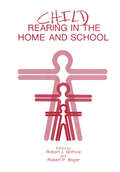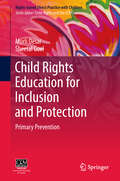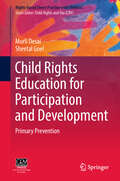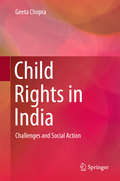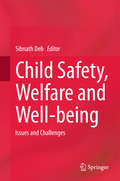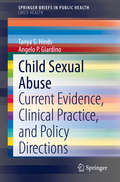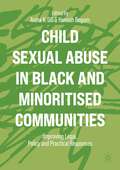- Table View
- List View
Child Psychotherapy Homework Planner (PracticePlanners)
by Arthur E. Jongsma L. Mark Peterson William P. McInnis Timothy J. BruceBeneficial take-home assignments for young psychotherapy clients and their parents The Child Psychotherapy Homework Planner, Sixth Edition provides ready-to-use, between-session assignments designed to fit most therapeutic modes. Organized by presenting problem, this homework planner covers 36 issues, including anxiety, depression, adoption, academic underachievement, ADHD, low self-esteem, and PTSD. In this new edition, the homework assignments have been modified to be more accessible to children. Assignment sheets can be easily photocopied, and they are also available online to download and print—making client-specific modification simple. This easy-to-use sourcebook features: Nearly 100 ready-to-copy exercises covering the most common issues encountered by children A format that’s easy to navigate, including cross-references to alternate assignments that are relevant across multiple presentations Expert guidance on how and when to make the most efficient use of the exercises Clearly referenced correspondence with the The Child Psychotherapy Treatment Planner for a complete treatment approachThe Child Psychotherapy Homework Planner is a high-quality resource that practitioners can use to improve care and accountability. This is a valuable planner that will save therapists time on office work so they can focus on patients.
Child Psychotherapy Homework Planner (PracticePlanners)
by Arthur E. Jongsma L. Mark Peterson William P. McInnis Timothy J. BruceBeneficial take-home assignments for young psychotherapy clients and their parents The Child Psychotherapy Homework Planner, Sixth Edition provides ready-to-use, between-session assignments designed to fit most therapeutic modes. Organized by presenting problem, this homework planner covers 36 issues, including anxiety, depression, adoption, academic underachievement, ADHD, low self-esteem, and PTSD. In this new edition, the homework assignments have been modified to be more accessible to children. Assignment sheets can be easily photocopied, and they are also available online to download and print—making client-specific modification simple. This easy-to-use sourcebook features: Nearly 100 ready-to-copy exercises covering the most common issues encountered by children A format that’s easy to navigate, including cross-references to alternate assignments that are relevant across multiple presentations Expert guidance on how and when to make the most efficient use of the exercises Clearly referenced correspondence with the The Child Psychotherapy Treatment Planner for a complete treatment approachThe Child Psychotherapy Homework Planner is a high-quality resource that practitioners can use to improve care and accountability. This is a valuable planner that will save therapists time on office work so they can focus on patients.
The Child Psychotherapy Progress Notes Planner (PracticePlanners)
by Arthur E. Jongsma Jr. Katy Pastoor David J. Berghuis Timothy J. BruceCreate effective treatment plans for children quickly and efficiently The newly revised sixth edition of the Child Psychotherapy Treatment Planner is a timesaving, easy-to-use reference for practitioners seeking to clarify, simplify, and accelerate the treatment planning process so you can spend less time on paperwork and more time with your clients. Each chapter begins with a new evidence-based Short-Term Objective and two new Therapeutic Interventions, emphasizing evidence-based and empirically supported interventions likely to be effective and meaningful in therapy. The latest edition also contains new and revised evidence-based Objectives and Interventions, more professional resources and best-practice citations for the non-EBT chapter content, and more suggested homework assignments. The book also offers: Two entirely new chapters: Bullying Victim and Disruptive Mood Dysregulation Disorder An updated self-help book list in the Bibliotherapy Appendix A Integrated DSM-5/ICD-10 diagnostic labels and codes in the Diagnostic Suggestions section of each chapter Updated and expanded references to research supporting the evidence-based content contained withinAn essential resource promoting the efficient use of practitioner time, the Child Psychotherapy Treatment Planner belongs in the libraries of clinicians responsible for the development of treatment plans for children.
The Child Psychotherapy Progress Notes Planner (PracticePlanners #301)
by Arthur E. Jongsma Jr. Katy Pastoor David J. Berghuis Timothy J. BruceCreate effective treatment plans for children quickly and efficiently The newly revised sixth edition of the Child Psychotherapy Treatment Planner is a timesaving, easy-to-use reference for practitioners seeking to clarify, simplify, and accelerate the treatment planning process so you can spend less time on paperwork and more time with your clients. Each chapter begins with a new evidence-based Short-Term Objective and two new Therapeutic Interventions, emphasizing evidence-based and empirically supported interventions likely to be effective and meaningful in therapy. The latest edition also contains new and revised evidence-based Objectives and Interventions, more professional resources and best-practice citations for the non-EBT chapter content, and more suggested homework assignments. The book also offers: Two entirely new chapters: Bullying Victim and Disruptive Mood Dysregulation Disorder An updated self-help book list in the Bibliotherapy Appendix A Integrated DSM-5/ICD-10 diagnostic labels and codes in the Diagnostic Suggestions section of each chapter Updated and expanded references to research supporting the evidence-based content contained withinAn essential resource promoting the efficient use of practitioner time, the Child Psychotherapy Treatment Planner belongs in the libraries of clinicians responsible for the development of treatment plans for children.
The Child Psychotherapy Progress Notes Planner (PracticePlanners #301)
by Arthur E. Jongsma Jr. L. Mark Peterson William P. McInnis David J. BerghuisSave hours of time-consuming paperwork The Child Psychotherapy Progress Notes Planner, Fifth Edition contains complete prewritten session and patient presentation descriptions for each behavioral problem in the Child Psychotherapy Treatment Planner, Fifth Edition. The prewritten progress notes can be easily and quickly adapted to fit a particular client need or treatment situation. Saves you hours of time-consuming paperwork, yet offers the freedom to develop customized progress notes Organized around 35 main presenting problems, from academic underachievement and obesity to ADHD, anger control problems, and autism spectrum disorders Features over 1,000 prewritten progress notes (summarizing patient presentation, themes of session, and treatment delivered) Provides an array of treatment approaches that correspond with the behavioral problems and DSM-5 diagnostic categories in The Child Psychotherapy Treatment Planner, Fifth Edition Offers sample progress notes that conform to the requirements of most third-party payors and accrediting agencies, including CARF, TJC, and NCQA Presents new and updated information on the role of evidence-based practice in progress notes writing and the special status of progress notes under HIPAA
The Child Psychotherapy Progress Notes Planner (PracticePlanners #301)
by Arthur E. Jongsma Jr. L. Mark Peterson William P. McInnis David J. BerghuisSave hours of time-consuming paperwork The Child Psychotherapy Progress Notes Planner, Fifth Edition contains complete prewritten session and patient presentation descriptions for each behavioral problem in the Child Psychotherapy Treatment Planner, Fifth Edition. The prewritten progress notes can be easily and quickly adapted to fit a particular client need or treatment situation. Saves you hours of time-consuming paperwork, yet offers the freedom to develop customized progress notes Organized around 35 main presenting problems, from academic underachievement and obesity to ADHD, anger control problems, and autism spectrum disorders Features over 1,000 prewritten progress notes (summarizing patient presentation, themes of session, and treatment delivered) Provides an array of treatment approaches that correspond with the behavioral problems and DSM-5 diagnostic categories in The Child Psychotherapy Treatment Planner, Fifth Edition Offers sample progress notes that conform to the requirements of most third-party payors and accrediting agencies, including CARF, TJC, and NCQA Presents new and updated information on the role of evidence-based practice in progress notes writing and the special status of progress notes under HIPAA
The Child Psychotherapy Progress Notes Planner (PracticePlanners #160)
by Arthur E. Jongsma Jr. L. Mark Peterson William P. McInnis David J. BerghuisThe Child Psychotherapy Progress Notes Planner, Second Edition contains complete prewritten session and patient presentation descriptions for each behavioral problem in The Child Psychotherapy Treatment Planner, Third Edition. The prewritten progress notes can be easily and quickly adapted to fit a particular client need or treatment situation. * Saves you hours of time-consuming paperwork, yet offers the freedom to develop customized progress notes * Organized around 33 main presenting problems that range from blended family problems and children of divorce to ADHD, attachment disorder, academic problems, and speech and language disorders * Features over 1,000 prewritten progress notes (summarizing patient presentation, themes of session, and treatment delivered) * Provides an array of treatment approaches that correspond with the behavioral problems and DSM-IV-TR(TM) diagnostic categories in The Child Psychotherapy Treatment Planner, Third Edition * Offers sample progress notes that conform to the requirements of most third-party payors and accrediting agencies, including the JCAHO and the NCQA
The Child Psychotherapy Treatment Planner: Includes DSM-5 Updates (PracticePlanners #294)
by Arthur E. Jongsma Jr. L. Mark Peterson William P. McInnis Timothy J. BruceA time-saving resource, fully revised to meet the changing needs of mental health professionals The Child Psychotherapy Treatment Planner, Fifth Edition provides all the elements necessary to quickly and easily develop formal treatment plans that satisfy the demands of HMOs, managed care companies, third-party payors, and state and federal agencies. New edition features empirically supported, evidence-based treatment interventions including anxiety, attachment disorder, gender identity disorder, and more Organized around 35 behaviorally based presenting problems including academic problems, blended family problems, children of divorce, ADHD, and more Over 1,000 prewritten treatment goals, objectives, and interventions—plus space to record your own treatment plan options Easy-to-use reference format helps locate treatment plan components by behavioral problem Includes a sample treatment plan that conforms to the requirements of most third-party payors and accrediting agencies including CARF, The Joint Commission (TJC), COA, and the NCQA
The Child Psychotherapy Treatment Planner: Includes DSM-5 Updates (PracticePlanners #294)
by Arthur E. Jongsma Jr. L. Mark Peterson William P. McInnis Timothy J. BruceA time-saving resource, fully revised to meet the changing needs of mental health professionals The Child Psychotherapy Treatment Planner, Fifth Edition provides all the elements necessary to quickly and easily develop formal treatment plans that satisfy the demands of HMOs, managed care companies, third-party payors, and state and federal agencies. New edition features empirically supported, evidence-based treatment interventions including anxiety, attachment disorder, gender identity disorder, and more Organized around 35 behaviorally based presenting problems including academic problems, blended family problems, children of divorce, ADHD, and more Over 1,000 prewritten treatment goals, objectives, and interventions—plus space to record your own treatment plan options Easy-to-use reference format helps locate treatment plan components by behavioral problem Includes a sample treatment plan that conforms to the requirements of most third-party payors and accrediting agencies including CARF, The Joint Commission (TJC), COA, and the NCQA
The Child Psychotherapy Treatment Planner (PracticePlanners)
by Arthur E. Jongsma Jr. L. Mark Peterson William P. McInnis Timothy J. BruceNow in its sixth edition, The Child Psychotherapy Treatment Planner is an essential reference used by clinicians around the country to clarify, simplify, and accelerate the patient treatmnet planning process. The book allows practitioners to spend less time on paperwork to satisfy the increasingly stringent demands of HMOs, managed care companies, third-party payors, and state and federal agencies, and more time treating patients face-to-face. The latest edition of this Treatment Planner offers accessible and easily navigable treatment plan components organized by behavioral problem and DSM-5 diagnosis. It also includes: Newly updated treatment objectives and interventions supported by the best available research New therapeutic games, workbooks, DVDs, toolkits, video, and audio to support treatment plans and improve patient outcomes Fully revised content on gender dysphoria consistent with the latest guidelines, as well as a new chapter on disruptive mood dysregulation disorder and Bullying Victim An invaluable resource for pracaticing social workers, therapists, psychologists, and other clinicians who frequently treat children, The Child Psychotherapy Treatment Planner, Sixth Edition, is a timesaving, easy-to-use reference perfectly suited for busy practitioners who want to spend more time focused on their patients and less time manually composing the over 1000 pre-written treatment goals, objectives, and interventions contained within.
The Child Psychotherapy Treatment Planner (PracticePlanners)
by Arthur E. Jongsma Jr. L. Mark Peterson William P. McInnis Timothy J. BruceNow in its sixth edition, The Child Psychotherapy Treatment Planner is an essential reference used by clinicians around the country to clarify, simplify, and accelerate the patient treatmnet planning process. The book allows practitioners to spend less time on paperwork to satisfy the increasingly stringent demands of HMOs, managed care companies, third-party payors, and state and federal agencies, and more time treating patients face-to-face. The latest edition of this Treatment Planner offers accessible and easily navigable treatment plan components organized by behavioral problem and DSM-5 diagnosis. It also includes: Newly updated treatment objectives and interventions supported by the best available research New therapeutic games, workbooks, DVDs, toolkits, video, and audio to support treatment plans and improve patient outcomes Fully revised content on gender dysphoria consistent with the latest guidelines, as well as a new chapter on disruptive mood dysregulation disorder and Bullying Victim An invaluable resource for pracaticing social workers, therapists, psychologists, and other clinicians who frequently treat children, The Child Psychotherapy Treatment Planner, Sixth Edition, is a timesaving, easy-to-use reference perfectly suited for busy practitioners who want to spend more time focused on their patients and less time manually composing the over 1000 pre-written treatment goals, objectives, and interventions contained within.
Child Psychotherapy, War and the Normal Child: Selected Papers of Margaret Lowenfeld
by Cathy UrwinPart I is an extended biography of Margaret Lowenfeld. Part II contains examples of her contributions to paediatric medical research, psychological theory, and psychotherapeutic technique.
Child Rearing in the Home and School
by Robert P. Boger Robert J. GrifforeThis volume is intended to address contemporary aspects of child rearing in the home and the school, as well as major dimensions of inter face between the home and the school. The authors of these chapters have used varying styles and approaches, and the range of perspectives is very broad and inclusive. An essential notion integrating all chapters is that child rearing is a human ecological concern of dominant importance for the home, the school, and the community during the 1980's and that this will continue to be true in the future. This volume is intended to be useful as a reference book, as a text, for researchers and for policy-makers. It is hoped that the volume also will be of use to parents, teachers, school administrators, child-care workers and others who are interested in child nurturance. The editors wish to extend appreciation to many individuals who made this effort possible. Our colleagues, Hiram Fitzgerald and Marjorie Kostelnik, have been most helpful and encouraging. We thank them for their patience, support, and invaluable editorial assistance during the production of the camera-ready copy of the volume. We also thank Barbara Taylor for her assistance in typing the chapters, and Carrie DeMyers for typing the camera-ready copy. Carrie's good-nature and posi tive outlook helped to smooth over the many frustrations inherent in the assembly and production of anthologies such as this one.
Child Refugee Asylum as a Basic Human Right: Selected Case Law on State Resistance
by Sonja C. GroverThis book addresses the intersection of various domains of international law (refugee law, human rights law including child rights international law and humanitarian law) in terms of the implications for State obligations to child refugee asylum seekers in particular; both as collectives and as individual persons. How these State obligations have been interpreted and translated into practice in different jurisdictions is explored through selected problematic significant cases. Further, various threats to refugee children realizing their asylum rights, including refoulement of these children through State extraterritorial and pushback migration control strategies, are highlighted through selected case law. The argument is made that child refugee asylum seekers must not be considered, in theory or in practice, beyond the protection of the law if the international rule of law grounded on respect for human dignity and human rights is in fact to prevail.
Child Rights Education for Inclusion and Protection: Primary Prevention (Rights-based Direct Practice with Children)
by Murli Desai Sheetal GoelThe aims of child rights education are to make children and their primary duty-bearers aware of child rights so that they both can be empowered to together advocate for and apply them at their family, school and community levels. This sourcebook focuses on child rights education for primary prevention related to inclusion and protection. Child rights education for exclusion, non-discrimination and inclusion is discussed in the context of family and society with reference to girls, children with disability, and Dalit and tribal children, and child rights to cultural and financial inclusion. Child rights education for protection comprises prevention of violence against children with reference to physical abuse/ corporal punishment and bullying, commercial exploitation of children with reference to child labour and trafficking and sale of children, sexual abuse and exploitation of children, problems in adolescent sexual relationships such as violence, teenage pregnancy, abortion and unwed motherhood, and sexually transmitted infections and HIV, child marriage, and conflict with law. This is a necessary read for social workers, lawyers, researchers, trainers and teachers working on child rights across the world, and especially in developing countries.
Child Rights Education for Participation and Development: Primary Prevention (Rights-based Direct Practice with Children)
by Murli Desai Sheetal GoelThe aims of child rights education are to make children and their primary duty-bearers aware of child rights so that they both can be empowered to together advocate for and apply them at their family, school and community levels. This sourcebook focuses on child rights education for primary prevention with reference to participation and development. The introductory chapter covers child rights values of peace, dignity, tolerance, freedom, equality and justice and child rights principles of dignity of the child, primary consideration to the best interests of the child, universality and non-discrimination, and state and societal accountability. Child rights to participation focuses on child rights for playing a decisive and responsible role in their own life and a participatory role in the family, schools, associations, community and with the state as citizens. Child rights to development includes child rights to free, compulsory, comprehensive and quality education, free of discrimination and violence; child rights to play, recreational, cultural, and artistic activities and media literacy; child rights to health with reference to physical health and hygiene, healthy and hygienic food and nutrition, sexual health and prevention of substance abuse; and child rights to environmental education with reference to child rights to environmental harmony and hygiene and child rights to sustainable environment. This is a must-read for researchers, trainers, and other professionals working on child rights issues across the world, and especially in developing countries.
Child Rights in India: Challenges and Social Action
by Geeta ChopraThe book is a comprehensive compendium on child rights in India from a child development perspective. It discusses the challenges that Indian children face for survival, development and education, especially if they are marginalized through disability, lack of care, and poverty. The major issues expounded by the author in relation to rights are infant and child survival, early child development, street and working children, children in conflict with law, children with disabilities, child trafficking and child sexual abuse. The author goes further to delve into the causes, among which are high population, poverty, migration, illiteracy, poor legislation and deep-rooted social norms and behaviour. The book presents the existing policy and legal framework in India for each of these issues. The broad purpose of the book is to comprehensively discuss the roadblocks that the marginalized child in India faces, to understand the causes of these roadblocks and to evaluate government and civil society action for children in India.
Child Safety, Welfare and Well-being: Issues and Challenges
by Sibnath DebThis volume presents the unique features of child abuse and neglect and discusses proposed as well as experimented protective measures to create awareness about child rights and their implementation. Divided into four sections, the volume discusses (a) the nature and prevalence of child abuse and neglect, risk factors and impact; (b) issues pertaining to child rights with regard to nutrition, health and education; (c) rights of children with disabilities, HIV/AIDS, and in circumstances like disaster and adoption; and (d) field-based experiences of researchers in protecting child rights and preventing child abuse. The most important contribution of this volume is in providing an analysis of the current legal scenario of child protection, emphasizing the rights of different sections of vulnerable children. Professionals and academics specializing in this area from different academic backgrounds and regions have contributed chapters to this volume, creating a global and multidisciplinary forum for discussion. This volume is important for a wide range of professionals and researchers from the social sciences, law, medicine, and behavioral sciences. It is also beneficial for policy makers and law enforcement agencies working with children.
Child Sexual Abuse: Its Scope and Our Failure
by Rebecca M. BolenChild sexual abuse has become a prevalent topic of study and discussion in the fields of Child Psychology, Pediatrics, Law Enforcement, and Social Work. But even with the widespread knowledge of identifiable behavior in its victims and abusers, society's response to child sexual abuse is failing profoundly. Rebecca Bolen's authoritative book, Child Sexual Abuse: Its Scope and Our Failure, clearly defines the scope of child sexual abuse and addresses society's ability to respond to the problem. It is her thesis that society's response to child sexual abuse is failing because the policies, programs, and statutes designed to assess and identify abuse are grounded in historical and myth-bound theoretical child sexual abuse literature rather than in the empirical knowledge base. This comprehensive text on child sexual abuse covers: The historical conceptualization of child sexual abuse, starting with Freud. A review of the empirical literature on the incidence and prevalence of child sexual abuse. The professional response to child sexual abuse. The most sophisticated model of risk of child sexual abuse done to date. Two new models of understanding reactions by nonoffending guardians. The pervasiveness of the threat of extrafamilial abuse. £/LIST£ This text is divided into three main areas of discussion: Sociohistorical Context, Scope of the Problem, and Aftermath. This comprehensive review can be used not only as a text, but also as a primary reference for professionals in government, law enforcement, medical, mental health, and any agency that works with child sexual abuse offenders and victims.
Child Sexual Abuse: Current Evidence, Clinical Practice, and Policy Directions (SpringerBriefs in Public Health)
by Tanya S. Hinds Angelo P. GiardinoThis brief approaches the challenging topic of child sexual abuse from an objective, evidence-based perspective. It offers an overview of child sexual abuse, including definitions and a clear explanation of the epidemiology. The text also explores the conceptual frameworks that seek to explain how a child comes to be sexually abused by an adult or older adolescent. In the chapters, the authors present credible prevalence and incidence studies that are used to provide a scientific response to how common this problem is. In addition, they address the policy implications for a myriad of prevention and treatment initiatives as well as related issues such as delayed reporting and the risk for sexual abuse within child serving organizations. Finally, the brief concludes with the authors' recommendations for the future on how best to prevent child sexual abuse in the first place. Prevention of child sexual abuse is very different than prevention of child physical abuse and neglect and requires a different framework and set of initiatives. Child Sexual Abuse: Current Evidence, Clinical Practice, and Policy Directions is a must-have resource for a range of professionals including healthcare providers, child advocates, clinical social workers, public health officials, mental health providers, and legislative staff professionals. It also is written in a readable manner for members of the lay public.
Child Sexual Abuse: Disclosure, Delay, and Denial
by Margaret-Ellen PipeThis volume provides the first rigorous assessment of the research relating to the disclosure of childhood sexual abuse, along with the practical and policy implications of the findings. Leading researchers and practitioners from diverse and international backgrounds offer critical commentary on these previously unpublished findings gathered from b
Child Sexual Abuse: Disclosure, Delay, and Denial
by Margaret-Ellen Pipe Michael E. Lamb Yael Orbach Ann-Christin CederborgThis volume provides the first rigorous assessment of the research relating to the disclosure of childhood sexual abuse, along with the practical and policy implications of the findings. Leading researchers and practitioners from diverse and international backgrounds offer critical commentary on these previously unpublished findings gathered from b
Child Sexual Abuse: A Public Health Problem in India
by Aminabee Shaik Suguna Leelavathi Thota Lakshmana Rao AtmakuriThis book is about child sexual abuse in India. Child sexual abuse (CSA) is a serious and wide-spread problem in India as it is in many parts of the world today. The trauma associated with sexual abuse can contribute to arrested development, as well as a host of psychological and emotional disorders, that some children and adolescents may never overcome. This edited book discusses the nature and incidence of the sexual abuse of minors in India and presents an overview of research findings to date. Socio-cultural and familial risk factors involved in CSA are discussed. Common symptoms and disorders associated with sexual abuse are outlined. The book also provides guidance on child protective services, coordinated response in preventing child abuse, mental health, and law enforcement. Finally, it discusses cognitive behavioral interventions to overcome the trauma caused due to sexual abuse.
Child Sexual Abuse in Black and Minoritised Communities: Improving Legal, Policy and Practical Responses
by Aisha K. Gill Hannah BegumChild sexual abuse (CSA) is believed to affect one in eight children worldwide (UNICEF, 2020). This authoritative book challenges widely-held problematic beliefs about CSA and discusses societal responses and attitudes to survivors. It brings together multidisciplinary expertise from key researchers and practitioners around the world to better understand CSA in Black and racially minoritised communities and to provide recommendations for improving legal, policy and practical responses. It provides an international overview, covering theory, practice and policy and action-oriented research to determine how countries can individually and collectively work to prevent CSA with specific, vulnerable groups and in general. It also examines how intersectional marginalisation affects experiences of, and responses to, CSA. This essential body of work is thoroughly researched and includes first hand testimony which will deepen the understanding of students, academics, policy-makers and professionals including social workers, service staff and activists working at the frontline.Chapter 7 is available open access under a Creative Commons Attribution 4.0 International License via link.springer.com.
Child Sexual Abusers: A Community Treatment Approach
by Jackie CraissatiUniquely, this book aims to provide students and practitioners with a knowledge base in relation to child sexual abusers which is focused on practice - assessment, treatment and evaluation - but rooted in psychological theory. Its strength lies in the simplification and outlining of a coherent approach to this group of offenders that is afforded by the single-author treatment, particularly so given that this author has developed and managed a sex offender project in South East London which is now one of the largest, longest running, and most thoroughly evaluated in the country.







